Installation of heating a country house - the case is not
The problem of heating a private house is interesting because the owner has the freedom to choose any type of heating. Since the climate of certain latitudes is so harsh that the heating season lasts a very long time, the house should not only be warm, but always warm. The heating system should be thought out to the smallest detail, all the more so since all the costs, starting from the acquisition and ending with the operation, are borne by the owner.

The sequence of stages of installation
The construction of a new house allows you to choose the type of heating and design its scheme in advance, while the heating system will seamlessly fit into the new space.
The installation of heating in a house that has been in operation for a certain number of years requires a preliminary assessment of the load-bearing surfaces and power supply systems.

- The first step is to draft a project in accordance with SNiP 2.04.05-91 and this should be done by specialists.. Payment of their labor will pay off the productive work of the system.
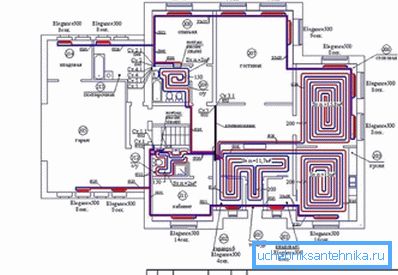
- Estimating and calculating the costs of future work and the purchase of a boiler, pipes, radiators, and fittings.

- Installation of the boiler is the starting point of the entire system, therefore it is extremely important to adhere to standards and norms.
- Pipeline laying, installation and connection of radiators. If you are satisfied with only pipes, the work will take less time, but it will be impossible to regulate the temperature in the rooms.
- The final stage, when the system is filled with coolant, which, under operating pressure, will allow to detect possible leaks. If they are, they must be eliminated, otherwise the heating system is ready for operation.
Note! In country houses, gas and fire inspectors check only the boiler room and chimney. You should get to know these people and the requirements they will make before starting the installation work. As a rule, the conditions of acceptance of these elements of the heating system differ in different areas.
Relatively cheap and cheerful
No super-modern heating system is unable to work productively in the absence of good thermal insulation of the house - from roof to floor. Since the house has been heated, the turn has come to choose the heating system, each of which has its own pros and cons. Consider the characteristics of available and popular energy carriers.
Gas
Reasonable price and cozy heat that can quickly heat an area of more than 100 squares are overshadowed by a whole bunch of inconveniences and "contraindications":
- clearance permit;
- separate room for the boiler;
- constant monitoring and the impossibility of a long absence;
- the absence of a gas pipeline.
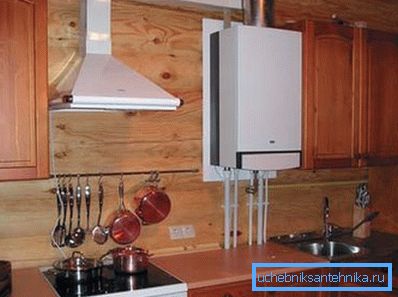
Electricity
Installation of home heating with electrical systems is productive in small houses and does not require permission over. The boiler or convector is mounted faster than gas, and the installation of warm film or cable floors will allow to heat only the required areas.
Electronic settings allow you to adjust the temperature in different rooms and depending on the time of day, reducing it at night and raising the day. Very convenient is the function of SMS control, when you can turn on the heating on the way to the house.

The disadvantages include:
- insufficient power grid of the residential area / settlement;
- unprofitability of use in areas exceeding 100 m2;
- burnout of cable warm houses, which will become a real disaster, while burning a separate section in the film version will not damage the entire coating;
- high-frequency squeak, if you laid the floors with your own hands, could make a mistake, but it is possible the marriage of the manufacturer.

Liquid and solid fuel boilers / stoves
In places not rich gas mains and powerful electric lines with heating cope solid fuel boiler. Fuel is loaded once a week, and then the work continues automatically.
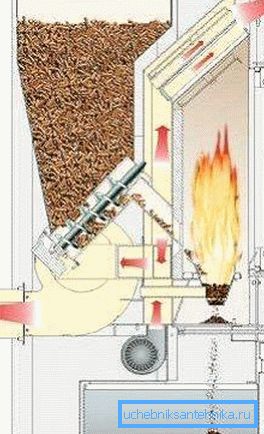
You can use an ordinary stove or a buleryan / brenern type, which will be convenient if you have inexpensive firewood.
Certain disadvantages of such heating are:
- for the stock of pellets, calculated in tons, you need a dry room;

- purchase and delivery of fuel;
- the considerable price of a pellet boiler;
- the need for equipment of the boiler room, which will lead to the loss of the useful area of the house;
- mandatory energy source for the operation of the automation of the unit, otherwise the water in the pipes will freeze with all the attendant circumstances;
- It is necessary to periodically add firewood to an ordinary wood heating stove, which will not allow you to relax for a long time.
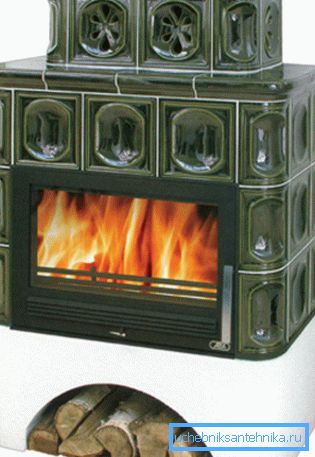
If there is a shortage of firewood, it is possible to create heat in the house with the help of a liquid fuel boiler, such as fuel oil or diesel fuel. For the fan, of course, energy is needed, but within reasonable limits, so the liquid-fuel heater can be called an independent energy source.
A fly in the ointment will be:
- a separate building for the boiler room and a storage tank for fuel, which has a specific smell;
- a plot of land to keep a container of fuel buried in the ground if it is not possible to do it under the roof;
- electric generator in case of power failure, for uninterrupted operation of automation.
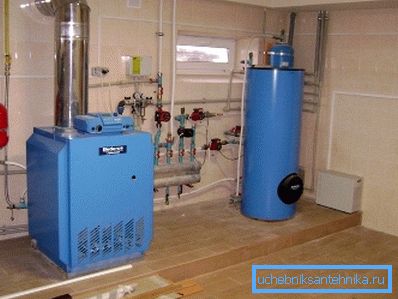
Note! Whatever boiler you choose, do not forget about the annual preventive measures conducted by specialists.
Natural heat
This refers to the heat pump is an environmentally friendly production, which supplies heat, "pumping" it out of the ground and water. Such heating of a country house would be appropriate for large areas - more than 200–300 m.2.
The superior qualities of the device are darkened:
- a very large cost, which afford maybe a big campaign, office or hotel;
- the contour located in the ground deprives it of its economic value, and the repair of the system is too expensive.
Once a pipe, two pipe
The layout has several options, each of which requires a different amount of material. The cheapest but inefficient one-pipe system is connecting the radiators in series. The disadvantage is the gradual heat loss from one heater to another.

Balancing valves, radiator regulators, taps on the bypass and connecting each radiator allow the entire chain to work if the repair of heating of a country house requires the disconnection of one device.
The supply line should be inclined. A riser to the second floor fits up to the first radiator. Refusal of the circulation pump in favor of the natural circulation of the coolant makes the wiring completely autonomous.
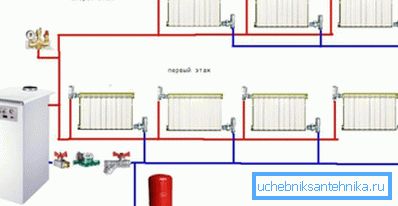
Note! Increasing the number of sections in the last radiator will accordingly increase the heat-giving area, improving the heating of the room.
Layout using the two-pipe circuit is more expensive because it uses a large number of pipes, and longer. The advantage of the scheme lies in the uniform flow of coolant. A drain valve is installed at the bottom of the system, and a drain valve is installed at the top and on the heated towel rail.
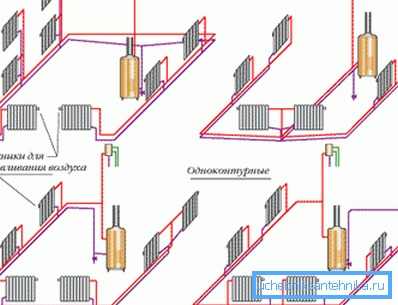
Beam or collector wiring is mounted on each floor and its essence is reduced to the connection of all taps, radiators with separate pipes to the distributor. The disadvantage of the scheme is the high cost and large number of pipes, which is justified by stable pressure at any point of the heating system.
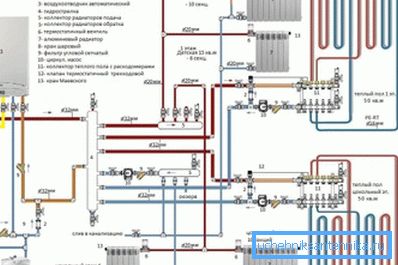
Which boiler to choose
On the one hand, it seems that the more powerful the boiler, the better, the more automatic cope with the problems itself.
On the other hand, spending the potential of installation at half strength:
- components wear out faster;
- reduced boiler efficiency;
- automatic failure;
- condensation forms faster in the chimney;
- extra spending on the purchase of new parts.

For all types of boilers, a general instruction is applicable for calculating the capacity for which in a room up to 3 m high for every 10 m2 1 kW of power is required. Add 15% of spare capacity for an autonomous circuit with unstable pressure and 20% for a boiler that heats and supplies water.
The calculation formula is as follows: W = S x Wud,
Where
W - boiler power (kW);
S - the total area of the house (m2), including all rooms;
Wud - average power density (kW / 10 m2) in different climatic zones is:
- in the south, 0.7–0.9;
- in the middle lane - 1–0.2;
- in the Moscow region - 1.2–1.5;
- in the north - 1.5–2.
Calculate the power of the boiler for heating a house of 150 squares in the suburbs:
W = 150 x 1.3 / 10 = 19.5 kW.
For water supply, we increase the indicator by 25% and get the figure of 24.4 kW - the desired value.
Summarizing
A house from scratch in the green zone is not a cheap pleasure, and sometimes repairs are more difficult than new buildings. If you have enough strength to give it all, saving is not worth it on a high-quality heating system. Trusting some stages of planning and installation to specialists, the guarantees of high-quality heating operation increase significantly. The comfort and peace of your family and the safety of the building will depend on the heating system.
If you are familiar with plumbing, the video in the article will reveal 3 secrets that will significantly increase your professional level.